My company tax year runs May – April and although I keep a tight rein on my accounts throughout the year, I only do management reporting annually when I break down my revenue in various ways to figure out what I need to change, stop doing or do more of.
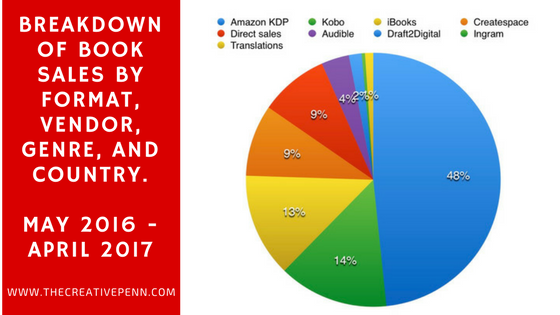 You can read my 2015-2016 breakdown here, and now here's this year May 2016 – April 2017. These figures are all based on revenue, the money that has actually come into my bank account.
You can read my 2015-2016 breakdown here, and now here's this year May 2016 – April 2017. These figures are all based on revenue, the money that has actually come into my bank account.
Because I publish through so many sources, I don't actually track book sales numbers very often. Let's be honest – the money is more important anyway!
Total sales and income
I make money from multiple sources – book sales, affiliate sales, course sales, sponsorship and Patreon, and speaking fees. It's all documented in How to Make a Living with your Writing, available in all formats.
The business as a whole is up 34% on last year, and my book sales income is almost 3x the UK national salary for a man, up 12% on last year. Not a massive increase, but then, I didn't put out many books!
I make more money than most authors, based on the Guardian report that average earnings for British authors are just £12,500.
I also make significantly less than some authors I know – some indie, some traditionally published. But I am very happy with the way things are going – and I have never had a breakout success, so I continue to subscribe to the consistent hard-working author model! You don't need to be a household name to make a decent living with your writing 🙂
Here's the more detailed breakdown.
 Breakdown by vendor
Breakdown by vendor
Amazon is still the dominant source of my book sales income, but at 61% in total (including Createspace and Audible), it is still less than a lot of authors and even publishers.
I'm particularly pleased that direct sales are now 9% of my revenue. I use selz.com and you can buy my non-fiction from me directly on each of the book pages here. That was almost zero last year, and now it's equal to Createspace. Selling direct means a higher % of royalty to the author, so I certainly intend to keep building that channel.
Translations are a tiny, tiny sliver of income and I made the decision to pull all my fiction translations, paying off the translators in order to concentrate on licensing rights through Curl Up Press. I'm getting my rights back from the German publisher this July, and then the only translations I'll have out are in French for non-fiction, which is going quite well. Basically, it is too early in the foreign language markets to make a decent return on translations and marketing is near impossible without a series, or if the translator has an existing market.
 Breakdown by format
Breakdown by format
Considering how many reports there have been about the death of the ebook and the rise of print, it's important to note that most indies make most revenue from ebook sales.
And most indies don't use ISBNs for ebooks either, so none of this revenue is tracked by the ‘official' publishing industry reports. Since I don't use ISBNs for audio either, and most of my Createspace books have free ISBNs, you can see that the majority of my book sales revenue is not tracked by any industry reports.
I have started using my own ISBNs for a small number of print books through Ingram/Lightning Source, but most print sales happen on Amazon and they favor the Createspace version, so if you only measured my income as Curl Up Press sales on Nielsen BookScan, you would only see a drop in the bucket.
Breakdown of ebook sales by country
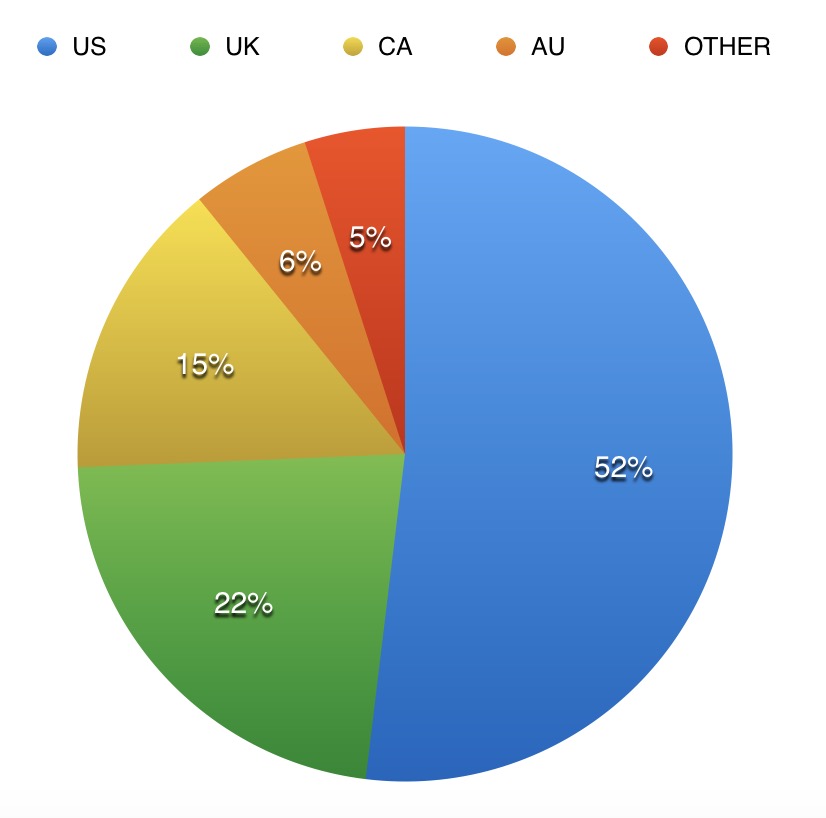
The future of book sales is global, digital and mobile – and I certainly want a piece of that action!
In the last year, 52% of my book sales income came from the US, with the main other countries being UK, Canada and Australia. I sold books in 49 countries in total in the last year (and have sold books in 83 countries in total).
Breakdown of fiction vs non-fiction
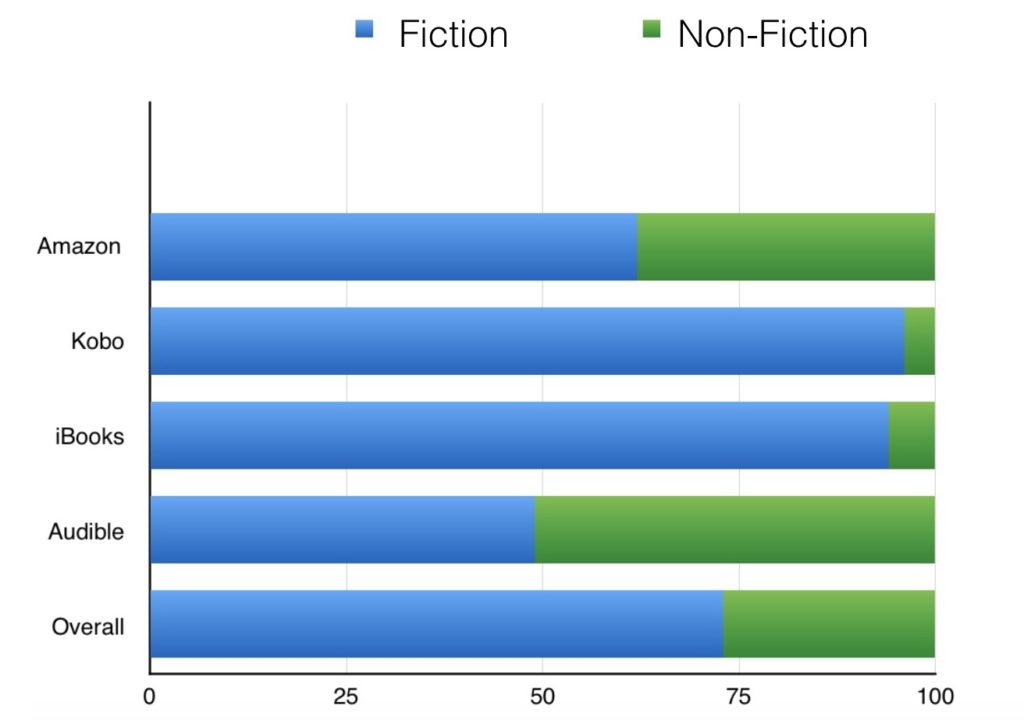
However, Kobo and iBooks are dominated by fiction sales, and that's because they have more merchandising opportunities for fiction than they do for non-fiction.
At Kobo, 77% of my fiction revenue is made up of box-sets.
In total, box-set sales make up 51% of my fiction revenue across the main 3 stores. If you're not using box-sets, you're missing out! Here's how you can set up your own box sets.
My Audible revenue is more heavily dominated by non-fiction, even though I only have 3 non-fiction up there right now. I think this is because:
- Non-fiction audio listeners are less price-sensitive so shorter books are still purchased or used in the subscription program
My fiction books are shorter than 8 hours, and Audible subscribers tend to favor longer fiction works because that is the best value for the subscription rate. This can be seen in my fiction audio boxset sales which are significantly higher than the individual books.
- I have an audio promotion platform through my podcast, so there is an ability to market the audiobooks
- I have gone with my own off-platform production so I get a higher royalty, instead of doing a revenue share as I have done for fiction
What will I do to increase book sales revenue in the next year?
(a) Put more books out 🙂 Simple, but it's not easy, as we all know. I now have 3 author brands, as I am co-writing sweet romance with my Mum. This is good in one way, as it gives me exposure to a bigger market, but it does dilute my attention from my other main brands, Joanna Penn for non-fiction, and J.F.Penn, for thrillers.
(b) Increase book specific marketing. I'll be using Amazon Marketing Services (Amazon Ads) to get more traffic to my ebooks in the US, and hopefully, they will be expanding the platform to other countries. I'll also be expanding my Facebook ads for more book sales and using my podcast to promote my own books more than I have been. We have decided to focus on one author brand per month, as opposed to scatter-gunning marketing whenever I remember to do it.
(c) Create more box-sets. Fiction box-sets work in sets of three, but I need to do more non-fiction box-sets as well, specifically for marketing on Kobo and iBooks. Hopefully, this will grow the sales there and make for a healthier split. I could consider going KDP Select for non-fiction, but that would mean I can't sell direct and my non-fiction direct sales are growing. So I'll be staying wide for my Joanna Penn books, and also my J.F.Penn series books.
(d) Expanding into Google Play. I've been saying this for a while, and I have looked at the various services, but I've been waiting for multi-currency pricing. I'm hoping PublishDrive will have it sorted this year and then I will use them for Play and some of the other European and Asian stores. This should also expand the countries I sell in.
(e) Licensing for foreign rights. One of the reasons for setting up Curl Up Press was to start investigating foreign rights and other rights licensing, so we'll be looking at these markets in the coming year.
How does this compare to your book sales revenue breakdown? I'd love to know what you think and also any questions. Please join the conversation by adding a comment below.
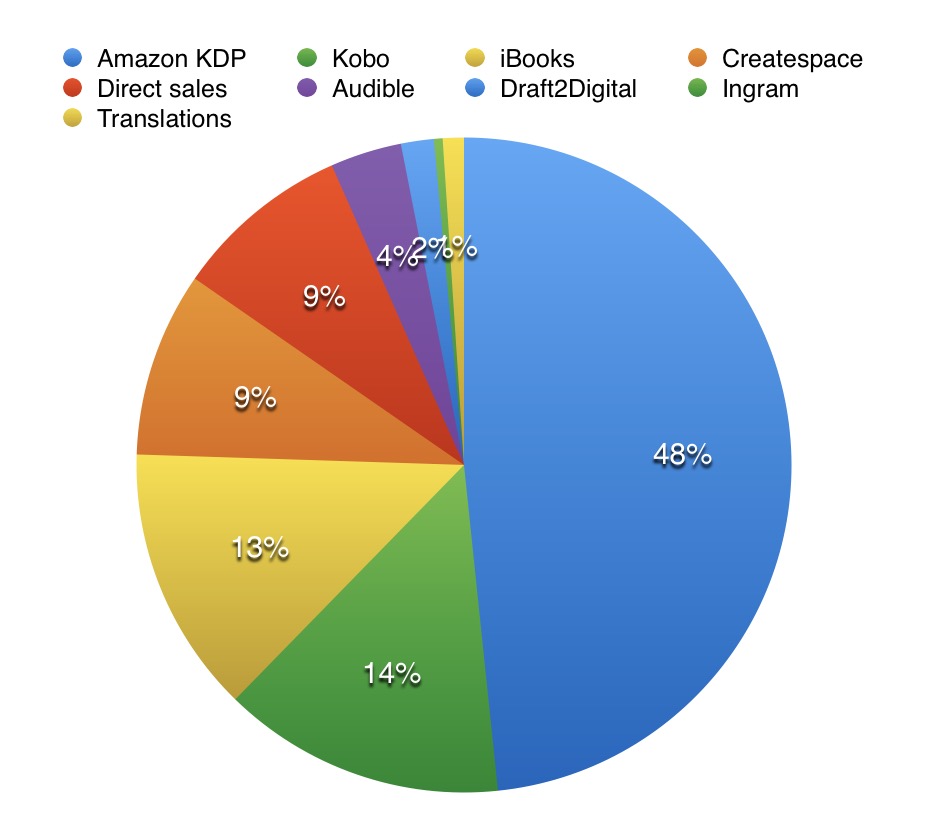 Breakdown by vendor
Breakdown by vendor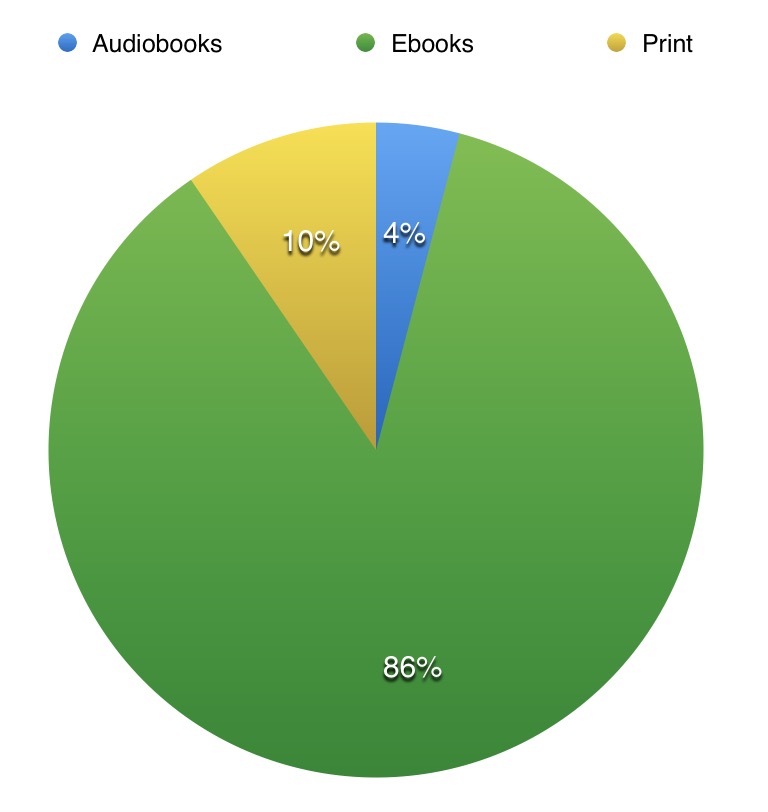 Breakdown by format
Breakdown by format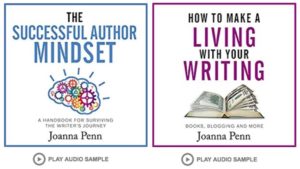
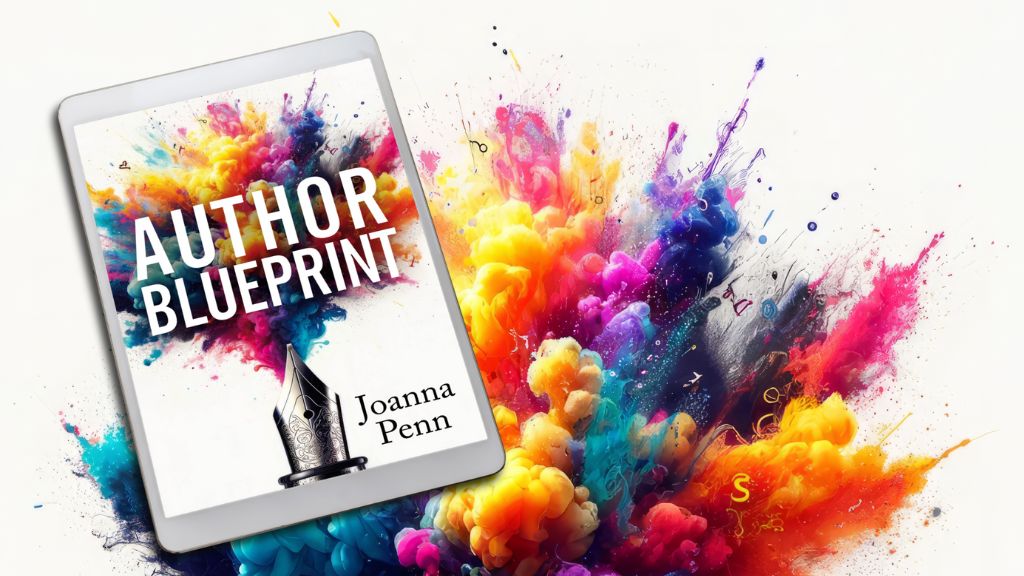
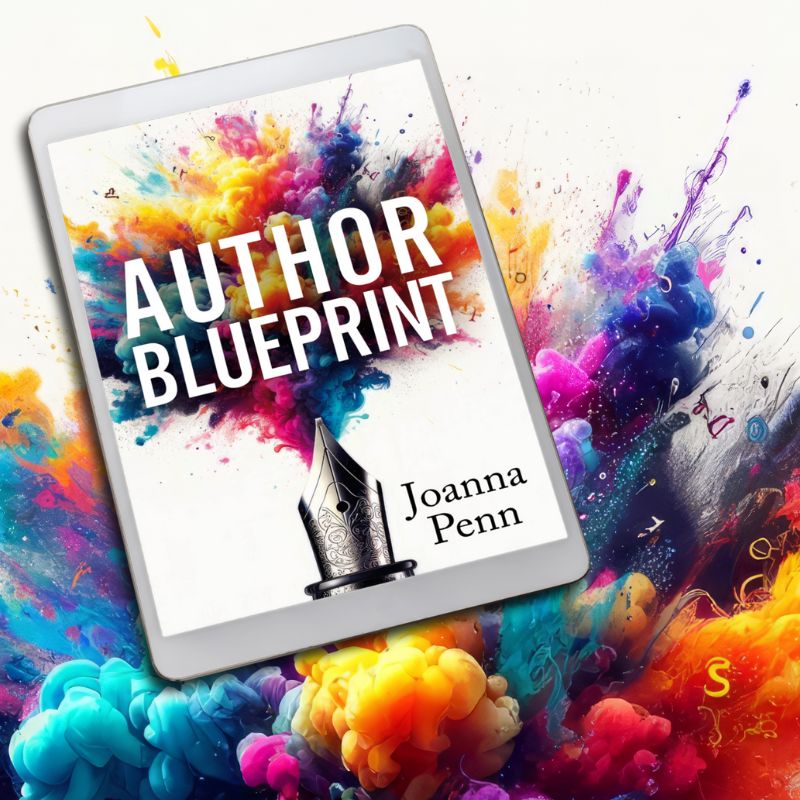
Where’s the breakdown by genre? It’s listed in the title, but nowhere in the article. I was curious what the breakdown was.
It’s fiction vs non-fiction – I write thrillers and self-help/books for writers, so only 2 genres 🙂
Always generous, positive and uplifting, thank you Joanna, not only for your brilliant books, but the sharing of honest, reliable and current information. http://www.creativepenn.com and your YouTubes provide an online ‘home’ to return to, doors always open with a welcome sign that makes you unique. Thank you again – no translation required!